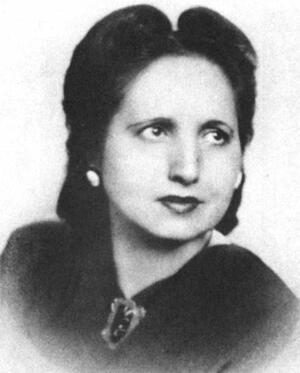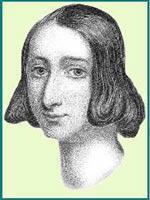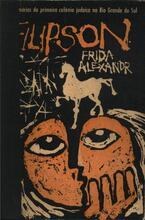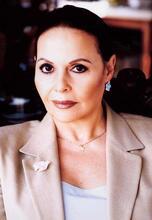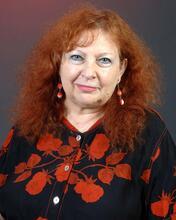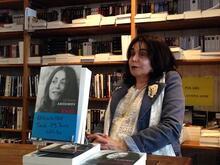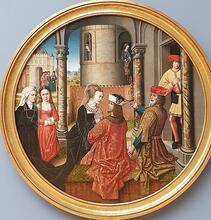Sarah Hamer-Jacklyn
Sarah Hamer-Jacklyn’s popular Yiddish tales not only painted a vivid portrait of the lost shtetl of her youth, but also added a dimension male authors of the time had missed: a nuanced picture of the lives of Jewish women. Her stories often explored subjects ignored by other writers: in “My Grandmother Weds,” an older woman defies convention—and her children—to remarry and begin a new chapter of her life, while in “My Mother’s Dream,” a ten-year-old girl confronts her parents’ fervent wishes for a son to carry on the family name. A dedicated writer who continued to work until her death, Hamer-Jackyn was highly praised for her rich descriptions of life both in the shtetl and in the immigrant communities of New York.
Sarah Hamer-Jacklyn, a popular and highly acclaimed author, brought a generous embrace and a well-honed theatrical sensibility to her short stories, sketches and portraits. She moved her characters and readers from the pious, rooted intimacy of the (Yiddish) Small-town Jewish community in Eastern Europe.shtetl to the fragmented, often despairing experience of America.
Early Life
Born in Novo Radomsk (Radomsko), Poland, on December 17, 1905, to a A member of the hasidic movement, founded in the first half of the 18th century by Israel ben Eliezer Ba'al Shem Tov.hasidic family, Sarah Hamer-Jacklyn immigrated to Canada with her parents in 1914.
Educated in the public schools of Toronto, she also received private Jewish lessons. Captivated at an early age by the Yiddish theatre in Toronto, she began her career as an actress and singer at sixteen, traveling with a troupe across North America and settling in New York.
Remembering Novo Radomsk
She made her writing debut in 1934 with the story “A shap maydl” (A Shop Girl), which was serialized in the Yiddish daily, Der Tog. Her work continued to be published in the Zukunft, Yidisher Kemfer, the Keneder Adler, the Forverts, and other Yiddish newspapers and periodicals in North America.
Her books Lebens un geshtalten (Lives and Portraits; New York, 1946); its sequel, Shtamen un tzvaygen (Stems and Branches; New York, 1954); and Shtot un shtetl (City and Town; Tel Aviv, 1965) portray life in the shtetl of Eastern Europe and in America. Hamer-Jacklyn's writing was praised by literary critics and the Yiddish press for its richly colored terrain, full-blooded characters, and vivid dialogue; her eyes and ears were attuned to the life around her: to customs, traditions, and practices of the shtetl and, later, to the ways of immigrants in the New World, America.
Poet and critic Jacob Glatstein (1896–1971) marveled at Hamer-Jacklyn’s capacity to capture, decades after her emigration, the spiritual climate, daily life, and family portraits of that vanished world; the shtetl still lived in her, he maintained. Her use of local dialect, idiom, and folklore contributed not only to the authenticity and freshness of her stories but to the preservation of linguistic aspects of pre-Holocaust Eastern European Jewish life and culture. Her khumish (Biblical) Yiddish was well suited to her fluent story telling. The authenticity of her voice allowed for additional dimensions to her shtetl portraits: seen through a child’s eyes, they were, at the same time, true childhood memoirs; as a totality they can be regarded as a Yizker bikhel (memorial booklet) commemorating Novo Radomsk, one of the destroyed Jewish communities of Eastern Europe.
Hamer-Jacklyn’s Women
In addition to familiar personalities in her narratives, Hamer-Jacklyn opened the stage and brought to life a large and varied cast of female characters, depicted with sensitivity and psychological insight seldom seen in the literature of the “Fathers.” With the entry on the scene of women who escaped the constrictions of that cramped world, the reader’s view expands, encompassing the diversity of Jewish life in Eastern European townships, especially as it touched upon gender relations.
One such story, “My Grandmother Weds,” from her book Shtot un shtetl, tells of a widowed grandmother who, defying her children, remarries, leaves her family behind and builds a future with her new husband in The Land of IsraelErets Yisroel.
Childbirth is at the center of the poignant story “My Mother’s Dream” from Shtamen un tsvaygn. Narrated from the perspective of ten-year-old Sorele, it reveals a complex, multi-layered society on the threshold of modernity. Familial tenderness and harmony, intergenerational discord, religious superstition—all these are expressed while awaiting and praying for the birth of a boy, a kaddish who will perpetuate the parents’ memory. Hamer-Jacklyn’s fine-spun details convey the inequitable hierarchy of the exalted male and the demeaned female.
Hamer-Jacklyn’s depiction of immigrant experience in America occasionally slips into stereotype: the jealous wife, wayward children. Nevertheless, through her stories we encounter a rich and varied tableau of characters: immigrants, their inner life still bound to the old home, struggling to fit into the New World; grieving parents whose children, eager to seize the day, have abandoned religious values. Her female characters, even as they struggle to attain their meager achievements, are strong and active: “shop girls” demonstrate friendship and class loyalty; a young woman in search of Broadway fame works as a burlesque performer. Hamer-Jacklyn included farmers and Jewish underworld characters, among others, in her assembly.
Sarah Hamer-Jacklyn lived most of her life in New York. Her marriage ended in divorce and she raised her son alone. She died on October 30, 1975.
Selected Works
Lebens un geshtalten. New York: Aroysgegebn fun der Novoradomsker sosayeti, 1946.
Shtamen un tsvaygen. New York: Aroysgegebn fun der Novoradomsker sosayeti, 1954.
Shtot un shtetl. Tel Aviv: Farlag Y.L. Perets, 1965.
“My Mother’s Dream.” In Found Treasures: Stories by Yiddish Women Writers. Edited by Frieda Forman et al. Toronto: Second Story Press, 1994.
Glatstein, Jacob. “Di dertseylerin Sore Hamer-Jaklyn” (The Story Teller Sarah Hamer-Jacklyn) In Der Tog-Morgen Jurnal, January 17, 1965.
Leksikon fun der nayer yidisher literatur. Niger, Shmuel and Yakov Shatsky, eds. New York: 1956.
Nevadovska, Rosa. “Sore Hamer-Jacklyns nay bukh” (Sarah Hamer-Jacklyn’s New Book), in the Zukunft, July–August, 1955.

